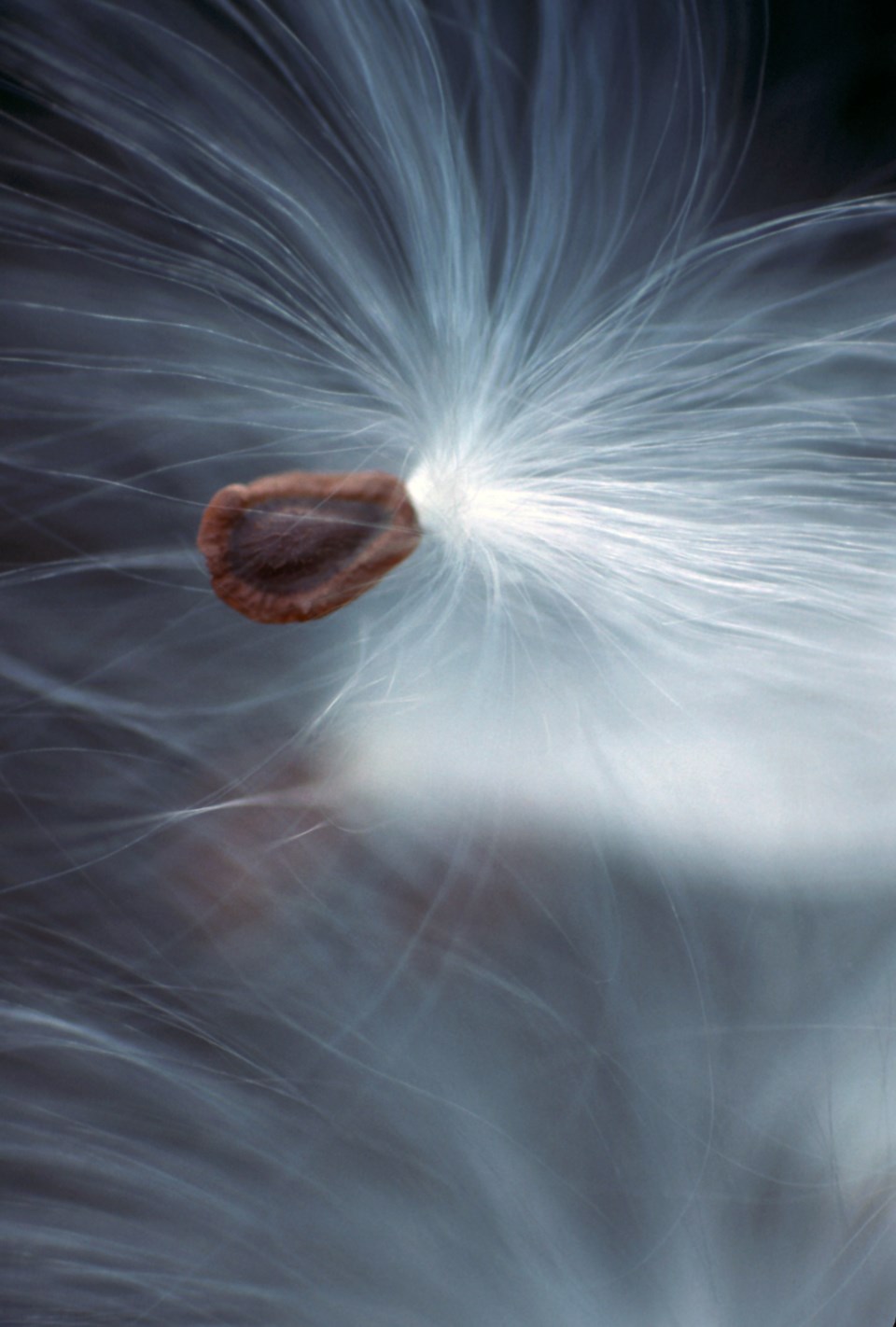As October drips into November, our outdoor excursions can become a tad chilly and damp, and it really does take an extra effort to appreciate the gifts of the season.
But snippets of beauty are indeed to be found, usually much more close up than the grand vistas of colour enjoyed just a few weeks ago.
For me, one these quiet joys is the annual Dance of the Milkweed Seeds.
As ripe pods split open and white-plumed seeds ready themselves for their entrance, my imagination puts them on a dimly lit stage with spotlights playing on their gentle ballet of movements.
I guess this is where ear-buds and an ipod could enhance the scene but so far I've managed to get by with just a few bars of some partially remembered orchestral song playing just behind my eyes.
From being lined up waiting in the wings to floating in a full blown aerial pirouette, these delicate seeds go forth to ensure future generations of themselves and those which depend on them... most notably the caterpillars of the monarch butterfly.
Milkweed are perennial, in that a plant will grow and regrow for several years until the depletion of the nourishment available in the soil surrounding their roots. But by then each plant will have launched several hundred, or even thousands, of seeds.
Ever wondered why a milkweed plant with dozens of blossoms creates only a few pods? Tricky cross-pollination is the answer.
A single milkweed blossom is built like a leg-hold trap, requiring the insect (usually a bee) to spread the jaws apart while hooking a pollen sac from inside. Usually they can't or don't do this. Sometimes the petals are spread but a foothold slips and the jaws snap shut... many times a dead bee dangling from an ensnared foot can be found on a milkweed's flower cluster.
But occasionally, almost rarely, a bee will successfully do the leg-trap shuffle with two blossoms and complete the transfer of pollen. Although only a couple blossoms do get pollinated, each will grow to produce a pod with many seeds packed within.
That white plume of material that lifts and carries the seed, borne of the wind to new locations, is a interesting thing. Unofficially called fluff, officially called floss, but scientifically called coma, the strands are actually hollow. Those in the know realize that a hollow something does two things fairly well: floats in water and insulates air.
This concept was not lost on the Air Force in World War II, so when the usual supplies of the insulating material for life vests worn by pilots became impossible to obtain, milkweed fluff was employed.
Thousands of school children in the 1940s collected grain bags full of milkweed seeds in the autumn for the war effort, thus ensuring all air crew members had a warm jacket and that those who had to bail and hit the water had a bit of flotation.
Very thankfully, our biggest woe these days with milkweeds is whether or not a butterfly caterpillar can find it as a food source.
If you are inclined to help provide a food garden next summer for monarch butterfly caterpillars, now is the time to get busy collecting seeds. Most of the pods are now opening, indicating full ripeness.
Collect a few pods and put them in a paper bag. Note that you should never, ever take more than about a third of anything from the wild. Rule of thumb is that one-third is for reproduction, one third is for other wildlife to utilize, and one third is what you have taken... use it wisely and well.
The intent is a reminder not to take every pod just because it's easy to do so.
The seeds now have to be separated from the coma (remember coma... it's the fancy word for fluff). This is done gently by hand, letting the seeds fall into a paper bag (never use a plastic bag as that traps moisture and enhances the possibility of mold to form).
The bag full of seeds now needs to be stratified. Strati... what? Many seeds need to undergo a cold period prior to gaining energy to grow. Without this cold shock many seeds will not germinate and you have wasted your time and a bag full of seeds.
One way to stratify is to place the seeds in moist potting soil and leave in the refrigerator for six weeks. Okay, four weeks if feel you really need the 'fridge back.
Next step prior to planting is scarification. Scari... what? The outside coat of the seeds needs to be roughened, perhaps even softened, to allow the new sprout to break out and put down roots.
Scarification of small seeds can be done by putting the seeds in a bag with coarse sand and shaking for a few minutes. The bag... shake the bag... not you!
Sowing of the seeds should be done into soil that is fairly open and can have full sun. Heavy vegetation like grasses will out compete the wee milkweed sprouts, and again your efforts will have been for naught.
If all goes as planned, the milkweeds will grow, caterpillars of several butterfly species may eat the leaves, bees will come to pollinate the flowers, and nature will ensure new pods are formed for the next fall season. And that's where you come in, again, walking along, humming a Bach, Beethoven or Tchaikovsky tune as you enjoy the marvels of the season.
